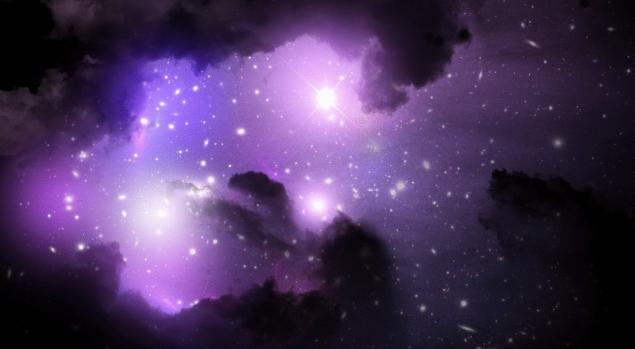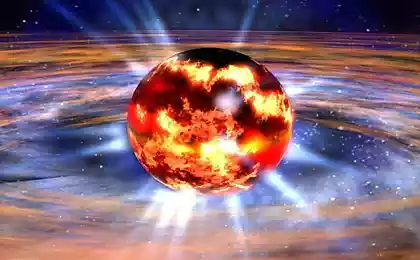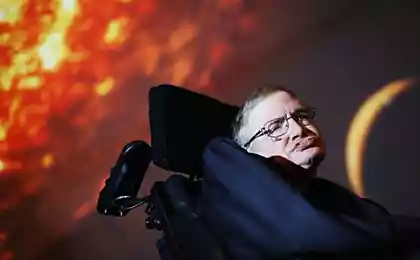727
10 questions about the Universe that will be answered by dark matter

Dark matter particles do not produce, do not reflect and not absorb light. However, although we can't see dark matter directly, and still do not understand its nature, scientists agree that it is up to 26% of the known Universe while observing the gravitational effects it has on other space objects. Like the wind, bending the tree, we cannot see dark matter, but we know that it is. Based on these observations, scientists develop some very interesting theories about this mysterious substance. If it is discovered, our understanding of the Universe significantly clearer.
Dark matter may cause mass вымирание

Michael Rampino, Professor of biology from new York University, believes that the motion of the Earth through the galactic disk (in our region of the milky Way galaxy) could cause mass extinctions on Earth. It happened because our movement has violated the orbits of comets in the outer Solar system (known as the "Oort cloud") and caused an increase in heat of the core of our planet.
Together with their planets the Sun goes around the center of the milky Way every 250 million years. During your journey it weaves through the galactic disk every 30 million years. Rampino argues that the passage of the Earth through the disk coincides with the fall of comets and mass extinctions on Earth, including what happened 65 million years ago when the dinosaurs became extinct. There's also a theory that just before the asteroid put an end to giant lizards, their ranks greatly thinned volcanic eruption.
The combination of unusual volcanic activity and collision with an asteroid coincide with the passage of Earth through the galactic disk: "During the passage through the disk of the concentration of dark matter violates the paths of comets, which, as a rule, fly far away from Earth in the outer Solar system," says Rampino. "This means that comets that usually travel at great distances from the Earth, choose an unusual path until the collision with the planet." Some believe that the theory Rampino doesn't work because the dinosaurs became extinct because of the asteroid and not a comet. However, 4% of the Oort cloud consists of asteroids, and it is about eight billion.
In addition to this Rampino believes that every passage of the Earth through the galactic disk have led to the fact that dark matter accumulated in the core of the planet. Since dark matter particles annihilate each other, they create intense heat, and it can cause volcanic eruptions, changes in sea level, height of mountains and other geological activity that seriously affects life on Earth.
The milky Way can be a giant червоточиной

Maybe we live in a giant tunnel, which is a short path through the Universe. As predicted by the General theory of relativity, a wormhole is a region in which space and time are distorted, creating a wormhole to a distant part of the Universe. According to astrophysicists from the International school of advanced studies in Trieste, Italy, dark matter in our galaxy can be distributed in such a way that delivers a consistently existing wormhole in the middle of our milky Way. These scientists believe that the time has come to rethink the nature of dark matter, maybe she is just part of another dimension.
"If we combine the map of dark matter in the milky Way with the last Big Bang model — said Professor Paolo Colucci, and assume the existence of space-time tunnels, we discover that our galaxy may have one of these tunnels, and this tunnel may be the size of the whole galaxy. In addition, we can even go through this tunnel because it is, according to our calculations, will be navigable. Like the one we saw in the movie "interstellar".
Of course, this is just a theory. But scientists believe that dark matter may be the key to creating wormholes and monitoring it. While there are no wormholes in nature have been discovered.
Opening galaxy X

X galaxy also known as galaxy dark matter for the most part invisible dwarf galaxy, which may be the cause of the strange ripples in the cold hydrogen outside the disk of the milky Way. It is believed that the galaxy X is a satellite galaxy of the milky Way in a cluster of four variables, Cepheids, pulsating stars that are used as markers for measuring distances in space. We don't see the rest of this dwarf galaxy because it is composed of dark matter, according to the theory. However, by the gravitational pull of the galaxy there is a ripple that we see. Without a source of gravity in the form of dark matter holding them together, the four Cepheids, most likely, would fly away.
"Discovery of Cepheids variables shows that our method of finding the locations of dwarf galaxies with a predominantly dark matter works, says astronomer Sukanya Chakrabarti. — It can help us ultimately to understand what makes up dark matter. It also shows that the theory of gravitation of Newton can be used in the farthest corners of the galaxy and there is no need to change our theory of gravity".
The decay of the Higgs boson to the dark материю

Developed in the 1970-ies the Standard model of particle physics is a set of theories, which essentially predicted all the known subatomic particles in the Universe and how they interact. Confirmed in 2012 the existence of the Higgs boson (also known as the "God particle"), the Standard model was completed. Unfortunately, this model explains not all and says nothing about gravity and dark matter. The mass of the Higgs particle also seems too small to some scientists.
This prompted scientists from the Technological University of Chalmers to propose a new model based on supersymmetry which equips each known particle of the Standard model heavier superpartners. According to the new theory, a small fraction of the particles the Higgs decays into a photon (particle of light) and two gravitino (hypothetical particles of dark matter). If this model is confirmed, it will completely overturn our understanding of the fundamental building blocks of nature.
Dark matter on Солнце

Depending on the method used to analyze the Sun, the amount of elements heavier than hydrogen or helium will range 20-30 per cent. We can measure each of these elements, looking at the spectrum of light, like a fingerprint, or to study how it affects the sound waves passing through the Sun. The mysterious difference in these two types of measurement items of the Sun is called the problem of the solar abundance (or abundance).
We need to accurately measure these elements to understand the chemical composition of the Sun, as well as its density and temperature. In many ways it will also help us to understand the composition and behavior of other stars and planets and galaxies.
For many years scientists could not develop an acceptable solution. Then astrophysicist Aaron Vincent and his colleagues hypothesized the existence of dark matter in the core of the Sun as a possible answer to the question. After checking many models, they came to the theory, which sort of worked. However, it included a special type of dark matter is "weakly interacting asymmetric dark matter," which could be either matter or antimatter at the same time.
Based on measurements of gravitation, scientists have learned that the Sun encircles the dark matter halo. Particles of asymmetric dark matter does not contain a lot of antimatter, so we can survive contact with ordinary matter and to accumulate in the core of the Sun. These particles can also absorb the energy in the center of the Sun, and then transported its heat to the outer edges that could explain the problem of the solar abundance.
Dark matter may be макроскопической

Scientists from Case Western Reserve doubt we looking for dark matter in the right places. In particular, they suggest that dark matter may consist of tiny exotic particles like wirrow (weakly interacting massive particles) and macroscopic objects, which range from a few centimeters to the size of the asteroid. However, the researchers limit the theory to what is already observed in space. Hence comes their belief that the Standard model of particle physics will give the answer. The new model is not needed.
Scientists call the objects of dark matter "macros". They do not argue that winow and axions not but admit that our search for dark matter may include other candidates. There are examples of matter which is neither ordinary nor the exotic, but which fit the parameters to the Standard model.
"The scientific community abandoned the idea that dark matter may consist of ordinary matter in the late' 80s, says Professor of physics, Glenn Starkman. We wonder whether it was wrong or whether the dark matter to consist of ordinary matter — quarks and electrons?".
Detection of dark matter in GPS

Two physicists proposed to use GPS satellites to search for dark matter, which, according to scientists, may not be particles in the conventional sense, but rather drips in the fabric of space-time.
"Our research pursues the idea that dark matter may be organized as a giant gaseous state collection of topological defects, or energy cracks, — said Andrei Derevianko from University of Nevada. — We propose to detect the defects, the dark matter, with a network of sensitive atomic clocks. The idea is that when the clock resynchronized, we will know that in this place was dark matter, the topological defect. In fact, we plan to use GPS satellites as the largest man-made detector of dark matter".
Scientists analyze data from 30 GPS satellites and trying to use them to test his theory. If dark matter really is of gaseous state, the Earth will pass through it as it moves through the galaxy. Speaking as the wind, shreds of dark matter will be blown away by the Earth and its satellites, causing the GPS clocks on the satellites and on earth will lose sync every three minutes. Scientists will be able to monitor discrepancies to one billionth of a second.
Dark matter can eat dark энергией

According to a recent research, dark energy can feed on dark matter as their interactions, which in turn slows the growth of galaxies and may ultimately leave the Universe almost completely empty. It is possible that dark matter decays to dark energy, but we do not know yet. The spacecraft Planck has recently revised figures of the physical composition of the Universe: 4.9% of ordinary matter, 25.9% of dark matter and 69.2% dark energy.
We cannot see dark matter or dark energy. These terms are not even very well painted by the scientific community. They are more like symbols, which will remain until we figure out what's really going on.
Dark matter attracts, dark energy repels. Dark matter is the frame or base on which to build galaxies and their contents. Its gravitational pull is believed to holds stars together in galaxies. Gravity is stronger when objects are closer to each other, and weaker when they are further away from each other.
On the other hand, dark energy implies a force that causes the Universe to expand, scattering galaxies away. As dark energy pushes the object, gravity weakens. This suggests that the expansion of space is accelerating rather than slowing due to gravitational effects as once believed.
"Since the end of 1990-x years, astronomers have become convinced that something causes the expansion of our Universe to accelerate, says Professor David Wands from the University of Portsmouth. — The simple explanation is that empty space — the vacuum has energy density, which is the cosmological constant. However, there is growing evidence that this simple model cannot explain the full range of astronomical data, access to scientists. In particular, the growth of cosmic structure, galaxies and clusters of galaxies is slower than expected".
Dark matter causes ripples in the galactic диске

If you look into space from Earth, we see that the stars suddenly over 50,000 light years from the center of our galaxy. Consequently, this end of the galaxy. We will not see anything serious until you step away for 15 000 light-years away from this boundary, the Ring of the Unicorn, stars, which are located above the plane of our galaxy. Some scientists believed that these stars were separated from another galaxy.
However, new data analysis in the course of the Sloan Digital Sky Survey showed that the Ring of the Unicorn is actually part of our galaxy. This means that the milky Way is at least 50% more than we thought — and the diameter of our galaxy increases with 100 000-120 000 light years to 150 000-180 000 light-years.
Looking from Earth, we do not see that they are connected because of the failures in the galactic disk. This ripple is similar to the concentric circles that radiate from the place of fall of a stone into the water. The tide rises and closes the view of the ocean, remain visible only higher waves. So although our view was partially blocked by the form of our galaxy, we saw the Ring of the Unicorn like the top of a high wave.
This discovery changes our understanding of the structure of the milky Way.
"We found that the disk of the milky Way is not just a disk of stars in the same plane, it is crimped, says Heidi Newberg of the Scientific school of Rensselaer. We see at least four depressions in the disk of the milky Way. And since these four cavities are visible only from our point of view, it can be assumed that such a ruffle across the disk of the milky Way".
Scientists believe that this ripple can be caused by a piece of dark matter and dwarf galaxies, had partially severed the milky Way. If this theory is correct, concentric depression of the milky Way will help the scientists to analyze the distribution of dark matter in our galaxy.
Gamma-ray сигнатура

Until recently, the only way by which scientists could detect dark matter, it observation its possible gravitational effects on other cosmic objects. However, scientists believe that gamma rays could be a direct indication that dark matter is hiding in our Universe. Perhaps they have discovered the first gamma-ray signature in the Reticulum 2, a recently discovered dwarf galaxy near the milky Way.
Gamma rays — a form of high energy electromagnetic radiation emitted from the dense centers of galaxies. If dark matter indeed consists of vimov, dark matter particles can be a source of gamma rays generated in the process of mutual annihilation of winow in contact. However, gamma rays may also be allocated to other sources like black holes and pulsars. If the analysis process will separate one from other sources, we can obtain gamma-rays dark matter. But this is only a theory.
Scientists believe that most dwarf galaxies lack a significant source of gamma rays, dark matter may consist of 99%. Because of that, physicists from the universities of Carnegie Mellon, brown and Cambridge got excited in connection with obtaining gamma rays from a Reticulum 2.
"Gravitational detection of dark matter has had little to say about the behavior of dark matter particles, says Matthew Walker of Carnegie Mellon. — Now we have a non-gravitational detection, which shows that dark matter behaves as a particle, and this is extremely important."
Of course, there's the possibility that the gamma rays come from other sources that have not yet been determined. However, the recent discovery of nine galacticredit dwarf with the Milky Way gives scientists the opportunity to further study this theory.published
Source: hi-news.ru























